9.4: Trace Fossils - Studies in Scurrying, Scraping, and Slithering
- Page ID
- 22650
As noted earlier, remains of organisms are not just found as body fossils. Trace fossils can yield interesting perspectives on how an organism lived and interacted with its environment. After all, if someone excavated your fossilized bones, would that tell your entire story? Would your bones and how were buried say anything about what you were doing at any point in time? Likewise, non-human organisms scurry, burrow, step, jump, run, walk, slither, and grow in a variety of ways. Traces of these actions are preserved in sediment and are studied under the branch of paleontology called ichnology.
Earliest trace fossils
Some of the earliest trace fossils are found in rocks that are around 3.5 billion years old, and preserved as structures referred to as stromatolites. These are macroscopic structures that have a dome-like shape. In them, wafer-thin mats of photosynthetic microbial mats (cyanobacteria) alternate with fine calcite mud. Initially flat, they grow increasingly convex through time, though the relief and size vary tremendously. Stromatolites require certain conditions to grow: (1) sunlight, and therefore shallow water, and (2) absence of grazing predators such as snails. They are still forming today in places like Shark Bay of western Australia and tidal channels in the Bahamas, both locations where predatory grazing by snails is absent. The high salinities and powerful scouring tides of these environments generally keep the snails away. The cyanobacteria that made the ancient stromatolites are not preserved, but are evidenced by the layers of sediment that stuck to the cyanobacterial mats. Since the Archean, evolution has led to more complex organisms using ever-changing forms of locomotion. New and unique forms of trace fossils emerged over time including horizontal and vertical burrows, and eventually, footprints.
Classification of trace fossils
Trace fossils are often classified by an ecological method that focuses on the behavior of the organism (see table).
Table \(\PageIndex{1}\): Trace fossil classifications (after Seilacher, 1967).
Note: Coprolites, or fossilized feces, are also considered traces but do not have a formal classification.
| Ethologic (behavior) class | Associated behavior | Example |
|---|---|---|
| Repichnia | Locomotion |
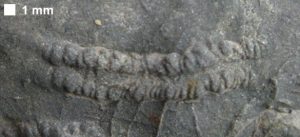
|
| Cubichnia | Resting |
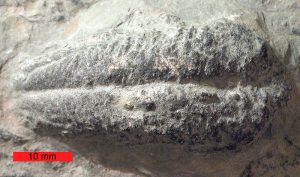
|
| Domichnia | Dwelling |
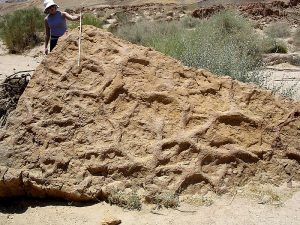
|
| Pascichnia | Grazing |
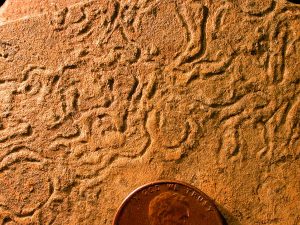
Helminthoposis trace fossil |
| Fodinichnia | Feeding burrows |
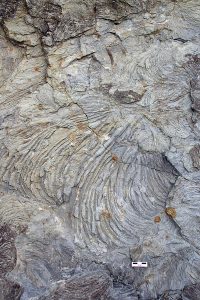
|
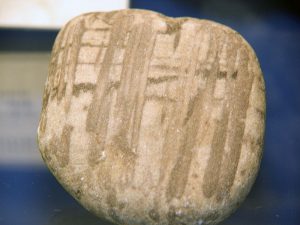
An alternative trace fossil classification is similar to the Linnaean system, creating an ichnotaxa from an ichnospecies within an ichnogenus. An example of such an ichnotaxa is Skolithos linearis–a long, straight, vertical burrow. Over time, ichnologists, or paleontologists who study trace fossils, have been able to show relationships among traces and how those traces change shape over time, using cladistic methods similar to those applied to living organisms.Unfortunately, it is usually very difficult to associate a particular organism with a particular t race. However, in rare instances, organisms such as trilobites have been preserved within a trace they created (e.g., Cruziana sp.). The real utility of trace fossils is in their association with particular environments.
Some traces are found in beach facies. Some traces are characteristic of beaches, while other different traces are typical of deep-water muds, and yet others are found in terrestrial mudflats. Even though the shape and movements of particular organisms play a role in how a trace fossil is formed, the characteristics of the sediment are just as critical to creating traces. Using uniformitarianism, geoscientists can use the tools of “neoichnology”, or the study of modern traces, to help understand traces found in rocks and to interpret their likely environment of formation. Importantly, many traces are time-independent. Organisms burrow now just as they did 400 million years ago; though the organisms may be different, the action is the same (Seilacher, 1967). Thus, trace fossils are excellent facies indicators and provide fabulous insights into the organisms and environments that formed them, and have been grouped into categories known as ichnofacies. Each ichnofacies is created by a community of ichnotaxa.
Trace Fossils - Quiz
Which of the following are considered trace fossils?
a. Bones
b. Shells
c. Burrows
- Answer
-
c. Burrows
True or false: It is always easy to match trace fossils with the organism that created them.
a. True
c. False
- Answer
-
c. False
Further reading:
University of California Museum of Paleontology Fossils
Seilacher, A. (1967). “Bathymetry of trace fossils”. Marine Geology. 5: 413–428. doi:10.1016/0025-3227(67)90051-5.


